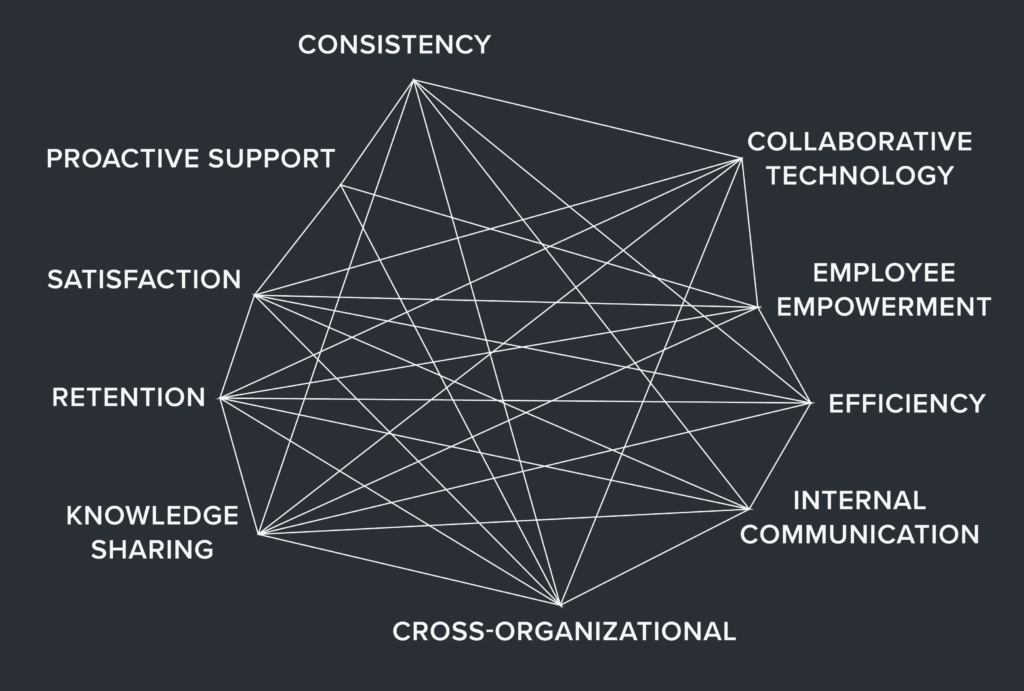No one enjoys getting tossed around like a hot potato when they call customer support.
If a customer is already struggling with your product or service, the last thing you want to do is add to their frustration. But that’s exactly what you’re doing by passing them around to different departments and having them repeat their issue again and again to different agents.
Here’s another problem with this scenario: customer support agents often require input or involvement from other providers, partners, teams, and vendors to resolve the issue.
Without shared access to ticket details and customer information, important details sometimes slip through the cracks and too much time gets wasted on back-and-forth communication. This means your customers are waiting even longer to resolve their issue and your support agents are struggling to deliver efficient solutions.
So, how can you empower your agents to deliver seamless customer support?
By adopting a collaborative support model and providing access to technology that makes it easy to work with multiple teams – both internally and across different organizations.
What is collaborative customer support?
Also known as tireless support, collaborative support empowers all team members to deliver exceptional, informed, consistent customer experiences.
It’s an approach to customer support that uses technology to give every team member access to the same ticket and customer information. This can include sharing notes about previous interactions, purchase history, details about their current issue, how many times they’ve called, who they’ve already spoken to, and what they’ve already been told or promised by a fellow agent.
Collaborative support works to bridge the communication gap that often exists between different support agents, teams, and even departments within your company – all for the purpose of providing seamless customer support.
The escalation model vs. collaborative support
Companies without collaborative support processes and technology in place rely on the escalation model of support (also known as tiered customer support).
With this type of organizational structure, support agents are divided into levels or tiers based on their experience and knowledge. The first point of contact is typically an entry-level agent who constantly searches for answers to incoming tickets.
Whenever an issue becomes too complex for a Tier 1 agent to resolve, they escalate the case to a Tier 2 agent. Likewise, if the Tier 2 agent is unable to resolve the problem, they will further escalate the situation until the customer connects with someone who can provide a solution.

The problem with the escalation model?
Well, there are a few.
First of all, this is a very reactive support model, since your agents only seek out solutions as new problems arise.
A tiered support system also doesn’t use your resource very efficiently or empower your agents to deliver quick solutions. This can end up costing you more down the line due to high rates of employee turnover and rising training costs.
Furthermore, the escalation model doesn’t provide your customers with the seamless support experience they deserve. In fact, it often requires your customers to interact with multiple team members – or even contact a different organization if the issue involves third-party providers or vendors.
All of this combines to lead to lower customer satisfaction rates, higher customer acquisition costs, and reduced customer loyalty. In short, the escalation model of support isn’t all that great for your customers, your employees, or your company.
Why collaborative support is preferable for everyone involved
Unlike the traditional tiered model of customer support, collaborative support focuses on resolving issues quickly and smoothly.

Rather than moving customers through a funnel or escalating their issue to different tiers, collaborative support operates on a network of shared knowledge, proactive support, and employee empowerment.
Still not convinced? Let’s take a closer look at some of the main benefits of moving towards a collaborative customer support model.
5 reasons to switch to collaborative support
1. Your support team will become more efficient
By working collaboratively to find solutions, your customer support agents can resolve tickets more efficiently. From your business’ perspective, this means increased productivity; and from your customers’ perspective, the result is faster answers and shorter wait times.
Since multiple agents and team members can work together to solve the issue more quickly, you can stop passing customers around until they find themselves speaking to the right person.
2. Your agents will provide higher-quality solutions
Thanks to the collaborative model, companies are no longer stuck in a one-agent-per-ticket system. Not only does this equate to smoother service processes, but the quality of the responses and solutions also improves.
If agents are empowered to learn and grow their expertise, you’ll end up with a team of experts who are happy to share their knowledge and support their peers. Encourage your team to share information in a central database that allows everyone with access to provide the same level of high-quality support, regardless of their individual expertise.
3. Your customers will be more satisfied with their experience

The more knowledge that’s shared between team members and providers, the more likely an agent can resolve a customer’s issue without transferring them to another department. This means your customers will receive answers faster no matter who they speak to.
The ideal customer support experience is easy-breezy for both your customers and your agents. Collaborative support enables your team to provide a seamless customer experience for the entirety of the customer’s lifetime with your company.
4. You’ll develop a reputation for fast, consistent support
Today’s customers have higher expectations than ever. It’s easy for anyone to look up a business online and read reviews that provide a realistic view of the service provided before they become a customer.
By the time a customer contacts your business for support, they’re already struggling with the issue at hand and eager to find a solution. They don’t want to be placed on hold or speak to five different agents until they connect with someone who can answer their question – and they definitely don’t want to be asked to repeat themselves every time they’re patched through to someone new.
5. Your business will build long-term customer loyalty
It’s easier (and more affordable) to retain existing customers than to constantly acquire new ones. Plus, securing repeat business can increase customer lifetime value and boost your ROI on customer acquisition costs.
Customer experience is a key factor in determining whether your customers will recommend your company to others and how likely they are to become repeat customers. That’s why customer loyalty is one of the most important characteristics of any brand or business – and why it’s worth moving to a collaborative support model.
Put simply, by providing collaborative support, you give your customers another reason to remain loyal to your business.
Putting collaborative support into practice
How can you implement your own collaborative support strategy? There are three things you need to get started: an empowered workforce, an open communication policy, and the right collaborative support technology.
Empower your customer support agents to succeed

Empowered customer support agents are successful customer support agents. So, give your customer support agents the authority to provide viable solutions more quickly.
Whether that means allowing agents to offer discounts without receiving permission from higher-ups or changing your policy to encourage more creative solutions, it’s important that your support processes align with the type of customer experience you want to provide.
Collaborative support allows individual agents to become experts in specific subjects and strengthens the entire team by spreading that knowledge around. Sharing knowledge not only results in better support solutions, but it also empowers individual employees to own the entire support process for each customer they serve.
Facilitate open lines of communication
Cross-departmental communication is key to a successful collaborative support model. Strive for improved communication that allows data and knowledge to flow freely between team members.
To provide the highest level of customer support possible, it’s crucial to not only collaborate with different teams and agents internally, but to work alongside any other providers, partners, and vendors involved in the customer experience.
You can use technology to facilitate communication between multiple partners and organizations so that you're always customers experience consistent, reliable support solutions – no matter who they call.
Invest in collaborative technology that makes it all possible

By investing in a customer support software solution, you allow multiple support agents to work together behind the scenes to find the best solutions. For example, customer support software like Relay makes it easy to bring teams together (internally or in separate organizations) for smoother, simpler collaborative support.
You can use Team Rooms to group together conversations around a particular team, project, or topic. Plus, shared ticket visibility ensures everyone involved has access to the ticket information, customer history, and any other contextual data needed to resolve the ticket.
Using the right collaborative support technology allows your entire support team to resolve customer issues more consistently, handle tickets more efficiently, and come together to provide better customer experiences overall.





